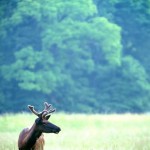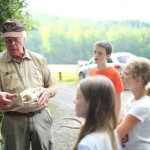- An elk stands in a pasture in Cataloochee, one of a group of about 140 that now call this part of the Great Smoky Mountains National Park home. In coming months, thousands of visitors will travel through the small valley to view the herd. photos by Colby Rabon, CPP
- Moriah Miller holds a large antler as Elk Bugle Corps volunteer Dave Nurek gives an impromptu presentation on the elk and their habits.
- Elk Bugle Corps volunteers like Dave Nurek keep a trunk full of skulls, bones, fur, and antlers to show and educate visitors about the herd.
On a recent May morning, Joe Yarkovich waded into the tall grass in a field in the Cataloochee Valley of the Great Smoky Mountains National Park. A wildlife biologist with the National Park Service, he was there to examine and collar a day-old 45-pound baby elk — the newest addition to a herd attracting thousands of visitors to this quiet, secluded valley.
To protect themselves from predators, the calves hide in the tall grass fields of the valley, staying motionless while their mothers feed. But once Yarkovich and his staff saw the spotted-and-scentless calf, they worked quickly, collaring it with a tracking device before his protective mother returned.
Although the new calf is a North Carolinian, he's of Canadian stock by way of Kentucky — a descendant of the group of elk introduced in 2001 and 2002 to Cataloochee Valley, located in Haywood County at the park’s eastern end. According to Yarkovich, elk calves are typically born in late May and early June. Eventually, he will likely tip the scale at 700 or 800 pounds.
For now, though, he can’t outrun a black bear.
With a smile, Yarkovich admitted that catching calves is his favorite part of the job. It may be the most important part, too.
“Their survival is what determines the future of the herd,” he said.
So, for three times a day over the next several weeks, park staff will monitor the calf’s movement through a signal relayed from the collar. But they won’t be the only ones keeping an eye on the giant animals.
With “elk tailgating” a popular Sunday-afternoon tradition here, tens of thousands of visitors will converge on the compact valley through the next several months — all to behold these elegant creatures from their bucket seats, truck beds and lawn chairs.
“We’re helping put back what we caused to go away”
The elk-and-tourist juxtaposition can seem strange at first. The herd of wild animals — with their unmistakable bugle and full antler racks — roam freely about as cars carry in lines of visitors packing picnics and portable chairs.
But, more and more, this has become a routine part of the Smokies — a land where the future is tightly wound in its past.
In fact, elk were once part of the area’s day-to-day landscape. They once covered three-quarters of the U.S. and thrived in the Southern Appalachians. But, like many other large grazers roaming here, habitat loss, disease, overhunting and competition from livestock led to their disappearance.
It wasn’t until 1990 that the Rocky Mountain Elk Foundation, an organization committed to the future of the animals, proposed that the Smokies reintroduce an elk herd. Bringing them back fit into the park's mission to preserve native species, Yarkovich said.
"Deciding where to put the elk was a big decision,” he said. “Cades Cove was an obvious choice, but not the best since it's relatively busy.”
Ultimately, officials chose Cataloochee because of its relative isolation, grassy fields and healthy forests. The first 25 elk arrived in February 2001, imported from the Land Between the Lakes National Recreation Area on the Kentucky-Tennessee border after being relocated from Alberta, Canada. Another 27 animals were added in 2002. Although there are several subspecies of elk, the ones that once roamed the Southern Appalachians are now extinct.
Yarkovich estimated that the Cataloochee herd may now number around 140, a rough estimate based on a 2009 population analysis.
“The herd is bigger and more stable, so we no longer monitor each animal,” he said. “The data looked really good; the survival rate was high and the population growth curve was positive. Everything indicated that they can be self-sustaining.”
“We’re helping put back what we caused to go away,” added volunteer Patty Davis, of Waynesville, who is a member of a volunteer group called the Elk Bugle Corps.
But the herd isn’t out of the woods yet. Disease, drought and bears could threaten the herd’s survival. There are also less obvious threats, such as over salting. “In the winter, cars come caked in salt,” Yarkovich said. “The herd’s figured out they can lick them.”
Volunteers try to reduce stress on park, elk, visitors
Their homecoming transformed this once-sleepy corner of the Smokies into one of its most popular destinations. Before the elks’ release, annual visitation averaged 75,000. Since then, it has doubled.
That’s put pressure on Cataloochee’s infrastructure — especially the valley’s lone road. Park Spokeswoman Dana Soehn said that road is much like putting a marble in a funnel. “They have to come out one at a time,” she said.
That’s where the Elk Bugle Corps comes in. Modeled after a similar program launched in 1990 in Rocky Mountain National Park, the all-volunteer corps has been an overwhelming success in the Smokies, Soehn said.
One or more volunteers work four-hour shifts at least twice a month from May to November. Roving the valley by electric vehicle, foot or bike, they educate visitors about the elk and assists rangers with safety and traffic control.
Although encounters are rare, interactions between elk and human visitors are a concern for park staff, since a human fatality could put the future of the herd, a single elk or visitors at risk. In fact, while many elk gazers never leave their seats on the sidelines of the pastures, others march far too close. That worries park officials, since elk are large animals that can move surprisingly fast.
Davis, who began volunteering in 2007, said she likes herding masses of tourists through the area despite some of the, well, stranger questions like “What time do they let the elk out?”
“Personally, I love the elk and to watch the valley change through the season, but the enthusiasm and the appreciation visitors have for the elk and the valley really fuels me," she said. “But the truth is most people are so far away from nature; they know so little about wildlife.”
Yarkovich agreed. He said visitors’ interest in the elk has plusses and minuses. There's more traffic, trash and crowds. But the elk also offer visitors an opportunity to connect with wildlife, the ecosystem and the park on a more intimate level.
Their return, it seems, can provide a sense that things are the way they should be.
But not everyone agrees. In its heyday, the valley was home to more than 1,000 residents after being settled in the early 19th century. By the time the park was established in the teeth of the Great Depression, most had been relocated. Now, a handful of the original structures — a schoolhouse, a chapel, empty homes — stand as an eerie reminder of the people who once lived here. For some, their ancestors’ removal from the valley remains a living memory.
"Occasionally I meet people who are still angry. I understand and don't blame them — it was their slice of paradise. It must have been very difficult to leave," Davis said, adding visitors also come to the valley to connect with the area’s human history. "But others have a long-term view: If the park hadn't been created then it might now be gated."
Of course, the elk were arguably here first. Watching them stroll past the chapel and lines of parked cars is a sight to see. Considering that, by 1900, the number of elk in the United States had been reduced from 10 million to less than 100,000 — their presence here is significant.
"There is something special about this place. It fills me back up. I love that," Davis explained, tears welling in her eyes. "It is a privilege to be here and do a little something to restore what was here. The elk are native and belong here. That feels good."
For more information about the Elk Bugle Corps or the elk herd, contact Park Ranger Pete Walker at 506-1739.
— Jack Igelman is a contributing reporter for Carolina Public Press, a nonprofit online news service providing Western North Carolina with unbiased, in-depth and investigative reporting as well as educational opportunities to journalists, students and others.







Before you comment
The comments section is here to provide a platform for civil dialogue on the issues we face together as a local community. Xpress is committed to offering this platform for all voices, but when the tone of the discussion gets nasty or strays off topic, we believe many people choose not to participate. Xpress editors are determined to moderate comments to ensure a constructive interchange is maintained. All comments judged not to be in keeping with the spirit of civil discourse will be removed and repeat violators will be banned. See here for our terms of service. Thank you for being part of this effort to promote respectful discussion.